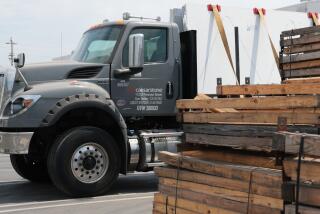Egyptian Craftsmen Built Pyramids : Archeology: A burial site debunks belief that the Pharaohs’ shrines were built by slaves. Workers apparently enjoyed their lives and jobs.
- Share via
GIZA PLATEAU, Egypt — Some people believe the Pyramids must have been built by beings from outer space or refugees from the mythical world of Atlantis. Others say slaves built them.
Egyptologists know better. Ancient Egyptians were quite capable of building their own Pyramids.
But it has been hard to prove because the Pyramid builders vanished, until now.
They are here on the Giza Plateau, in a cemetery not found until last fall, when a horse stumbled into a sand dune and onto the top of a tomb.
Each month has brought new discoveries and new tombs to shed light on the blue-collar workers of ancient times.
So far, the dig has revealed 50 tombs of foremen, workmen and their kin. Each is different, like none previously seen by Egyptologists. The labor force dates from the fourth dynasty, when the Pharaohs built the greatest Pyramids, until the sixth, 420 years later in 2150 BC.
Members of the archeological team believe that their work has just begun, that nearby dunes hide a cemetery of enormous size.
Egyptologist Zahi Hawass has spent years sifting clues left by the Pharaonic working class. There are discarded tools and graffiti praising the prowess of ancient construction teams with such names as Vigorous Gang, Enduring Gang, North Gang and South Gang.
He said the notion that slaves built the pyramids probably was invented by Greek and Roman tour guides who wanted “fat tips” from tourists of 2,000 years ago.
“Slaves build things because they’re forced to, but they could never build the Pyramids,” said Hawass, antiquities director for the Pyramids and the Sphinx. “These were built with genius, a genius impossible for slave labor.”
Nor were they extraterrestrials, a concept vigorously debated in the mid-20th Century by laymen and spiritualists. Their cemetery, filled with emotion, shows them to have been very human indeed.
A young mother is buried with her baby. Primitive, poignant sketches lead a foreman and his wife into the hereafter. A tomb is equipped with an outside spout so the deceased never would want for liquid refreshment.
The dig provides a surprising profile of the ancient blue-collar worker:
* He was far better off than had been thought, highly creative and industrious even when not building Pyramids or serving his Pharaoh with other work.
* Relationships between worker and boss, unlike slave and master, were very close. Foremen had their crews buried beside them.
* He demanded a piece of paradise as his king did, and was not above stealing something from the Pharaoh to make his own dreams of eternity come true.
“They used leftovers from the monuments they were building--bits and pieces of the Pyramids or the Sphinx or the tombs and temples,” Hawass said. “They hauled limestone, granite and basalt chips home for their tombs.”
For those exploring the cemetery, each day has its surprise.
This day’s challenge was to learn what was inside a mud-brick dome shaped like a beehive, one of two found so far.
It was perfect digging weather, except for wind gusts that blew sand in from the desert.
“I’d rather have this cemetery than a golden statue,” antiquities inspector Mohammed Shata said, whisking away layers of sand inside the mound.
“A statue you look at, record, then turn over to a museum,” he said. “This is our real heritage. It’ll keep us busy for years.”
As he dusted, Shata saw outlines of a skeleton emerge. “It’s a tomb,” he said. “I think the man was elderly. Here are bits of a sarcophagus.”
The man was buried in the fetal position, a common practice in the cemetery. His skull lay against a stone, facing the front wall.
Mansour Bouraik, another on-site inspector, said: “The stone was put there to block evil spirits. They placed the man, perhaps an elder of the family, toward the outer wall so he could always pick up the scent of offerings his family placed outside.
“Maybe he’s in a fetal position for magical reasons, or maybe because that’s the way he worked in life, bent over.”
Pyramid builders were of two types. Permanent workers labored full time in quarries or art workshops, and casual laborers came from farms to work for wages or exempt themselves from other government service.
Men interred in the cemetery were permanent workers for the Pharaohs, whether on the monuments or elsewhere.
A big surprise for the archeologists has been the expertise and creativity the workers showed in constructing their own tombs.
“If you were royalty, you had a certain type of tomb, but these workers wanted something great, too, and were free to use their imagination in building their own,” Bouraik said.
More to Read
Sign up for Essential California
The most important California stories and recommendations in your inbox every morning.
You may occasionally receive promotional content from the Los Angeles Times.













